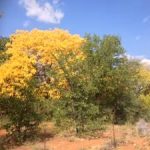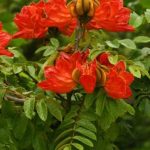TREE LIFE
June 2016
MASHONALAND CALENDAR
Saturday 4th June: Botanic Garden Walk. Meet at the car park at 0845 hours for 0900 hours. It will be good to have a brisk walk on a crisp morning to admire the autumn colours in the Garden.
Sunday June 19th: We have been invited to Forester Estate. There is a huge variety of tree species there and it promises to be an excellent day of botanising. Bring all you need for the day – water, food, drinks, chair, hat and anticipation for a great day out. We are starting early to make the most of the day, so we will meet at CABS Head Office car park at the end of Northridge Rd at 0715 hours for a very prompt 0730 hour departure.
Saturday June 25th: We have been asked by Clare Griffiths to walk with her and identify the trees on the University of Zimbabwe vlei. This is a venue we have wanted to visit for some time. Meet at the Veterinary Clinic car park at 1415 hours for a 1430 hour start. .
CHAIRMAN’S REPORT FOR THE YEAR 2015-16
I have pleasure in presenting my first annual Chairman’s report of the Tree Society covering the year 1 April 2015 to 31 March 2016.
The regular Tree Society series of monthly outings continued and we managed to organise eleven 3rd Sunday outings although two of them were changed at the last minute. Nine of the 4th Saturday walks took place during the year. Now that we have changed our Harare Botanical outings to a Saturday morning, we have had more tree walks mostly led by Tom Muller. Dave Hartung and others have come to our rescue when Tom Muller was not available.
The committee decided that car-sharing should continue but also decided that members should be given directions to the various venues in case they wanted to do their own thing.
The outings are summarised below:
Month Main Sunday outing 4th Saturday
April 2015 Was to be Barwick School but became CABS Head Office; Christon Bank
May 2015 Mukuvisi Woodlands (AGM) Rhett Butler
June 2015 Chedgelow Farm Botanic Gardens
July 2015 Bob Warren Codrington Doreen Richards and Mike Caufield
August 2015 Hildemara Park Rolf and Maia Chenaux Repond
September 2015 Calderwood Park No Outing
October 2015 Canon Kopje Rob Jarvis in Hillside
November 2015 Harare Botanic Gardens St Georges School
December 2015 Christmas Social at Val d’Or No outing
January 2016 Was to be Bushman Rock but became Mukuvisi Dave and Olwen Hartung
February 2016 Mountain View Farm, Bindura Graham Mills
March 2016 Bob Warren Codrington No outing
In addition to the regular monthly outings, there was a longer trip, to New Year’s Gift in Chipinge from 6th to 10th November, 2015.
This visit to Chipinge was organised by Mary Lovemore and was attended by 13 people. The three “Gurus’ all came on this outing. Botanising was rather challenging in that many trees were without leaves or just coming into leaf. On the day we went to Mount Selinda, we were joined by a further six people who joined us from the Mutare and Chimanimani areas.
I would like to thank Meg Coates-Palgrave, Mark Hyde, David Hartung and Tom Muller for leading us on most outings. I would also like to thank Ann Sinclair and other new leaders who took over some of the load.
Meg gave potential Tree Leaders a tree identification course which has resulted in the Society gaining new leaders, thereby leaving Meg and Mark to do their own thing at the outings.
Thanks to those who contributed write-ups on our outings and articles for Tree Life: Ann Sinclair, Bilal Khatri, Bob Nixon (1987), Dave Hartung, Erica Gees, Fran Mutapi, Isla Grundy, JP Felu, John Meikle, Karl van Laeren, Mark Hyde, Mary Lovemore, Meg Coates Palgrave, Genaro Pereira, Sarah Roberts and Soo Fawcett. A big thank you to JP Felu, who continued his excellent ‘Tree of the Month’ series, but unfortunately he is no longer able to continue. And apologies to anyone I may have missed out.
Membership: As at 31 December 2015, we had 129 members, of whom 112 were ordinary members, 3 honorary and 14 external.
Tree Mapping: Work on this project continued in the reliable hands of Maureen Silva-Jones. However, recently we terminated this project as the Zimbabwe Flora site is actually doing this work.
Isla Grundy continued as editor of Tree Life throughout the year and has been publicist for the Society. All members are encouraged to keep Isla supplied with material so she has a choice of articles.
The financial position of the Society remains satisfactory. The accounts and balance sheet were prepared by Bill Clarke and presented at the AGM.
The website has been kept up to date by Odette Lind and our thanks go to her for her hard work. However, the committee have decided that it is time for the website to have a face-lift.
Tree Society Facebook group: The group has shown an explosion of membership from 82 members in May 2013 to 433 members on 5 May 2014 and has now reached over 1800.
Scanning back-numbers of Tree Life: This exercise in re-typing Tree Life from 1994 and earlier years is being undertaken by Mary Lovemore. Eventually, these will appear on-line. Many thanks for Mary for undertaking this mammoth and time-consuming exercise. Is there anyone who would like to help?
Committee: Since the last AGM, there have not been any changes. The current committee consists of the following 7 people: Isla Grundy, Bill Clarke, Teig Howson, David Hartung, Mary Lovemore, Bilal Khatri and myself. My sincere thanks go to the members of the Committee for their hard work and support on behalf of the Society. A big thank you to Mary, she has done the most work in the past year for the Society.
Herbarium fumigation: Fumigation of the National Herbarium was carried out in December last year by Fumigation Services and again in May this year.
Tree labelling: is being carried out by the staff at the National Botanic Gardens – pushed by Dave Hartung and myself. Dave and I have also been labelling trees at Ewanrigg. There is a problem with identifying exotic trees and if anyone can help, please step forward.
Christmas Party: once again we held our Xmas Party at Val d’Or. Bill Clarke ran a scavenger hunt for thirty trees and all three teams found 27 of them – but not the same ones! But, one team found a tree from which they couldn’t reach the leaves and were awarded half a point for their effort, thus they won the hunt with 27.5 points! Thanks to Adele Hamilton-Richie who ran the quiz consisting of General Knowledge and Tree questions. Thanks to our hosts, Bill and Fiona Clarke – a good time was had by all.
In conclusion …the Society is in a strong position in terms of its finances and its membership.
2015-2016 was a successful and active year for the Society. Long may it continue!
– Tony Alegria, Chairman
PRONUNCIATION OF BOTANICAL NAMES Part 2 – “C”s and “G”s
In an article in BSBI News April 1995 No. 69 pg 43, entitled ‘Botanical Pronunciation – eleven rough guides’, Sean Edwards used the mnemonic “A gungy ginger gargoyle” to help remember when “G”s and “C”s are hard or soft. Thus a “C” or “G” is soft if followed by “e”, “i” or “y” and hard if followed by “a”, “o” or “u”. For the purpose of pronouncing botanical names in this article I will use “S” for a soft “C” and a “K” for a hard “C”. I will also use a “J” for a soft “G” and “G” or “GH” to denote a hard “G” – unfortunately, unlike “C” there is no suitable character to denote a hard “G”.
Of course nothing is as easy as that because there are exceptions, as you will see below, and people from different countries pronounce the Latin names very differently. The pronunciations below are pronounced as we would in English.
Some examples:
Albizia gummifera AL-BIZ-EE-AH GUM-IF-FER-RAH
Amblygonocarpus andongensis AM-BLEE-GONO-KAR-PUSS AN-DONG-GHEN-SIS
Bolusanthus speciosus BOL-YOU-SANTH-US SPE-SEE-OH-SUS
Boscia mossambicensis BOSS-EE-AH MOSS-AM-BIK-ENSIS
Calodendrum capense KAL-OH-DEN-DRUM KAP-ENSE-AY
Celtis gomphophylla SELL-TISS GOM-FOE-FILL-AH
Cyathea sp. SIGH-AY-THEE-AH
Dovyalis lucida DOVY-AH-LISS LOO-SID-AH
Gyrocarpus americanus J’EYE-ROE-KAR-PUSS A-MERRY-KAR-NUS
Protea gaguedi PRO-TEE-AH GAG-WED-EE
Searsia longipes SEER-ZEE-AH LONG-GHEE-PEZ
Searsia occidentalis SEER-ZEE-AH OX-ID-ENT-AH-LISS
Strychnos cocculoides STRIK-NOSS KOK-YOU-LOY-DEEZ
Syzygium guineense SIGH-ZIJ-EE-UM GHIN-AY-EN-SAY
Xanthocercis zambesiaca ZANTH-OH-SIR-SIS ZAM-BEE-ZEE-ARK-AH
– Tony Alegria (with lots of help from Dave Hartung and Mark Hyde)
SOME TREES OF MADAGASCAR
My trip to Madagascar in May 2014 can only give a superficial view of the flora, given that there is so much to absorb, no access to references and relying on local guides for names. Nevertheless the island must rival the Galapagos because the extent of specialisation is extraordinary, with 5,500 species of vascular plants (4,500 endemic), 280 bird species (111 endemic), over 100 lemur species (but no monkeys or baboons), the largest predator is a dog-sized fossa, crocodiles but no hippos, two thirds of the worlds chameleons species but no indigenous herbivores.
The west of the country is drier and covered with Hyparrhenia grassland savanna and dry deciduous forest, similar to our Lowveld. The east is wetter and this is where the worst degradation of primary forest has occurred, mainly caused by charcoal production and the shifting cultivation of the 17 million people.
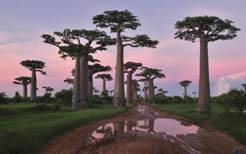
Adansonia grandidieri
We travelled by road and boat down the Tsiribihina river before travelling 120 kms North over the most appalling roads flanked by Hyparrhenia and Heteropogon contortus grassland reminiscent of Mashonaland interspersed with isolated Tamarindus indica (surprisingly not restricted to river lines) and very common Ziziphus mucronata. Our destination was the strange limestone formation of Tsingi of Bemraha, with hostile jagged spikes. The flora includes many succulent and aloe species, Pachypodium sofiense, Phoenix reclinata, Entada, Albizia, Diospyros species, Delonix regia (Flamboyant) and a Forandia species which bears its flowers on its stem.
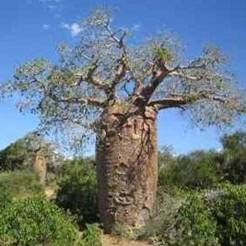
Adansonia rebrostipa
We then travelled South across the Tsiribihina river, along another appalling road, to the sea port of Morandava. We had seen our first baobabs on the river, but now we visited the famous avenue of the baobabs or “Mother of the Forest” as the Malagasy call them. Their evolution is intriguing. Madagascar split from Gondwanaland 50 million years ago, but the boababs are now considered to have split from the ancestral baobabs 7 – 17 million years ago. The theory is that Madagascar, which has 6 species, is the origin of the baobab, with one species (and possibly 2) evolving later in Africa and one in Australia, possibly from drifting seed pods. The much photographed avenue of the baobabs is not in a natural setting, because all of the under story dry forest has been destroyed. In this area we saw the bottle shaped Adansonia rubrostipa, the tall elegant A. za and also A. grandidieri. The other three baobab species are in the North and were not seen.
We had to visit the Kirindi Forest to see baobabs in their natural state. Interesting trees seen included a number of Commiphora species widely used for canoes, Colubrina sp or Military Tree with military camouflage on the trunk and strangely wet and cold to the touch, Fernandoa magnifica and Vanilla sylvaticus. Endangered and much exploited trees are from the Dalbergia genus, D. greviana, D. trichocarpum and D. boyeri.
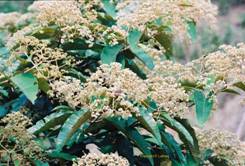
Hurungana madagascarensis
We next travelled to the East to see the remnants of primary forest. East of Antananarivo there are huge swathes of country are devoted to poorly managed Eucalypt plantations. The secondary forest has a host of invasive species, many familiar to us as well as some Asian ones. The Mantadia forest is undisturbed. Familiar trees encountered were the Hurungana madagascariensis as well as Anthocleista grandiflora. This is an interesting forest but I could get little information locally. There is a tree fern Shiateae meleri, various Pandanus species, Ocotea of the stinkwood family and Cryptocarya, or Wild quince, of which Zimbabwe has two species.
A fascinating country, easily accessible on a 4-hour flight from Johannesburg; very nice Malagasy people of mainly Malayan ancestry; a cheap destination with appalling roads and what can only be described by the oxymoron “disciplined chaos”. Well worth a visit and Cactus Tours is highly recommended. In 2014 we did 2000kms by 4×4, plane and boat for EUR 1500 each over 10 days. See it before it is gone.
– John Meikle
Postscript. Later press reports highlighted 700 tons of Madagascar rosewood (Dalbergia species) being intercepted in Mombasa en route to China.
BOTANIC GARDEN WALK – 7TH MAY 2016
Again, we were a very small group who took advantage of a most beautiful, crisp, clear morning to walk in the Garden, which always has some magical appeal.
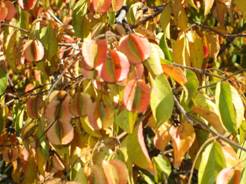
Combretum celastroides in its Autumn glory
There was much debate on many issues, not all of them being resolved. We looked at all the trees, commented on most of them, but of particular interest and looking absolutely stunning was the Combretum celastroides. This is a thicket-forming species and is one of the main constituents of the almost impenetrable “jesse bush” of the Zambezi Valley. The one we admired in the Garden was ablaze in its autumn glory, its small 4-winged fruit being bright red while the body of the fruit still remains greenish yellow, drying to a golden brown with a satiny sheen. This would be a good species to be included in Karl van Laeren’s “foliage safari” concept – see May 2016’s Tree Life. Imagine flying over the Valley’s jesse bush at this time of year! Another species mentioned by Karl, Kirkia acuminata, White Syringa, was also a sight to behold in the Garden at this time of year, its leaves splendidly gold and red coloured.
Albizia harveyi, Common false thorn, with its feathery leaves golden brown and velvety in the sunshine, looked very good. Its pods were flat, thin-valved and swollen above each seed. The next to draw attention to itself was Albizia anthelmintica, Worm-cure or False-thorn, flowering profusely which it usually does before producing new leaves. The white stamens in the flower form the half- spherical fluffy head, beautiful in the May sunshine. The bark of this tree is regarded as an anthelmintic especially against tape-worm and has for long been used in this way in Ethiopia and Somalia, hence the specific name.
Acacia mellifera – Blackthorn. Thorns in pairs below each node, hooked, blackish and very demanding!
We had to stop and admire the magnificent form, just pure artistry, of a particular specimen of Commiphora caerulea – Blue-barked commiphora – with its smooth, succulent looking, conspicuously milky blue bark with translucent, yellowish papery peel. This is one of my “must see” trees when visiting the Garden.
In a small thicket nearby was Cordia monoica (ex. ovalis). This attracted a huge amount of attention with its beautifully smooth pale grey/green/blue bark. Of interest to us was the way that where branches meet or touch each other, they merge and then continue on their way as one. Nearby, again, was Amblygonocarpus andongensis (see the article on the pronunciation of this name below) or Scotsman’s rattle.
Artabotrys brachypetalus, Purple hook berry, grows as a low spreading tree in low altitude areas along streams. This is most often a strong woody climber, climbing by means of the very distinctive, curling flower stalks (peduncles which twine around the branches and twigs of a neighbouring tree).

Dave’s baboon spider
There was another sort of excitement at the same time. Before we arrived Dave had noted a pair of baboon spiders either doing a mating dance or who were in full combat. As he approached them to record their dance on camera, the smaller of the two scuttled away and the other retreated down its hole. Dave pointed out the beautifully lined “den” and then encouraged the inmate to show itself by dipping a straw down the hole. There was an immediate response from both the spider and the audience. A real beauty, huge and hairy and very angry about the way life was going for it that day!
And so the morning went, with tit bits of information being thrown into the pool of knowledge and discussion by Meg, Dave, Ann, Tony, Dawn and myself, as we all enjoyed the warm May sunshine – what a beautiful morning to be out and about in our National Botanic Garden.
Photos: Ann Sinclair & Dave Hartung
– Mary Lovemore
OUTING AFTER THE AGM MUKUVISI 15th MAY 2016
After the formalities of the meeting were over and having enjoyed more social chit chat and catching up, we followed Dave Hartung, our Vice Chairman, round to the Blatherwick Gate entrance where he led a walk along the river.
It was a stunningly beautiful day and the first tree we discussed was Pterocarpus rotundifolius, Round-leafed blood-wood. This tree has two to five pairs of opposite to sub-opposite ovate to elliptic leaflets, almost as broad as they are long, plus a terminal leaflet which is usually almost perfectly circular (hence rotundifolius). The grey-brown bark is rough and longitudinally fissured. The winged pods are flat, sub-rotund, thickened over the single seed, and without bristles (unlike its cousin the Mukwa).
Ochna puberula, Granite plane, occurs in bushveld, usually on rocky outcrops, and that is exactly where we found it, growing out of the rocks almost! Growing alongside was a young Burkea africana (Mukarati in Shona). The dried and crushed bark of this tree is used as a fish poison, while the bark and roots are used in traditional medicine and for tanning. A red dye is obtained from the root. Caterpillars (karati) of the moth Cirina forda may occur in large numbers on the tree, often causing complete defoliation. Considered a delicacy, these caterpillars are collected in large numbers, roasted and dried. We might be able to serve them at the next AGM !
We discussed at length the attributes of Lippia javanica – Verbenaceae family – which has the rather nice old synonym Lantana lavandulacea. This is a pretty little herbaceous shrub with white flowers and delightfully fragrant leaves when crushed – the essence obtained from these has therapeutic properties used for depression, amongst other things.
Azanza garckeana, Snot apple or Tree hibiscus, whose flowers are yellow with a maroon patch in the centre, are very like our cultivated hibiscus. The fruit is edible while still green and juicy, the seeds and rind are discarded. When chewed the flesh is sweet and glutinous. The bark provides fibre. The wood is attractive, fine grained, with yellow sapwood and deep brown heartwood.
There were, of course Parinari curatellifolia, Mobola plum, a-plenty. Gymnosporia senegalensis, Confetti tree, was in full flower and very beautiful – it was not quite ready to drop its confetti-like petals. The Erythrina abyssinica had two little flowers, high up, so early to be flowering! Strychnos spinosa, Combretum molle, Terminalia sericea – each were discussed. We spotted a magnificently bonsai-ed Ficus burkei (or Ficus thonningii in some books), which had Bilal, our bonsai fanatic, in raptures. Also of note was the Grewia decemovulata, Miombo dwarf grewia.
We crossed the river, running clearly, by the rickety bridge and saw Albizia antunesiana, Purple-leafed false-thorn; Peltophorum africanum, African wattle; Syzygium cordatum, Waterberry; Ochna pulchra, Peeling bark ochna or Mermaid tree, has bark that is pale grey, sometimes roughish near the base, otherwise peeling thinly to reveal a beautiful, creamy, opalescent underbark – hence the name “Mermaid tree”. Monotes glaber, Pale-fruited monotes, has brown to dark brown rough bark especially on the lower parts of the trunk, tending to become smooth higher up. The root bark is dried, powdered and sprinkled on food twice daily to treat heart ailments. Lannea discolor, Live-long, the fruit of which is edible, having a pleasant grape like flavour, is much favoured by birds. The bark is used medicinally, for tanning, for twine and as the source of a red dye. Roots are split and used in basket making.
Diospyros lycioides, Blue Bush, was the last tree we looked at. The roots of these, chewed to fray the ends, are used as tooth brushes – all of us who have been on an outing with Bilal have been presented with tooth brushes – and it is the larval food plant for the butterfly, Poecilmitis lycegenes.
Of course, we only discussed a fraction of what we saw, but what interesting discussions we had. Again everyone put in their tuppence- worth of information, some of which led to great hilarity! We then crossed back over the rickety bridge, hoping not to be caught by the troll, and had a very pleasant picnic lunch interlude for which we were joined by Rob and Sheila. It was one of those “special” mornings.
– Mary Lovemore
TONY ALEGRIA CHAIRMAN


